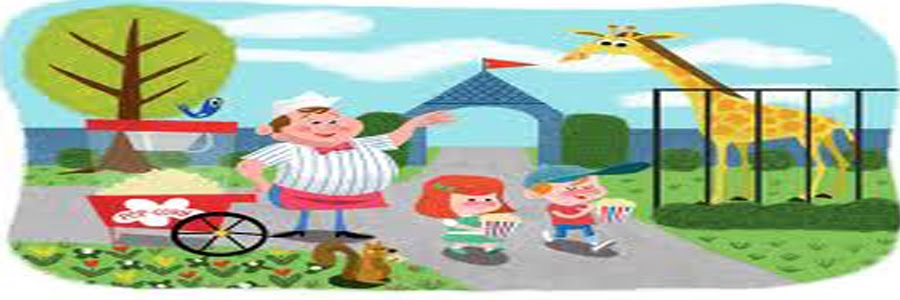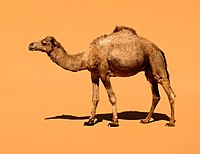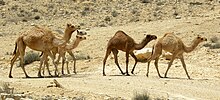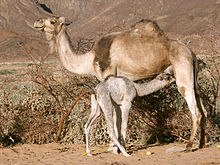Lahore zoo elephant
Wednesday 25 January 2012
Thursday 5 January 2012
Dromedary
Dromedary
From Wikipedia, the free encyclopedia
(Redirected from One-humped Camel)
For the world music group, see Dromedary (band).
| Dromedary camel | |
|---|---|
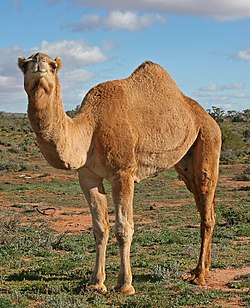 | |
| Conservation status | |
| Scientific classification | |
| Kingdom: | Animalia |
| Phylum: | Chordata |
| Class: | Mammalia |
| Order: | Artiodactyla |
| Family: | Camelidae |
| Genus: | Camelus |
| Species: | C. dromedarius |
| Binomial name | |
| Camelus dromedarius Linnaeus, 1758 | |
 | |
| Domestic dromedary range | |
The Dromedary (pronounced /ˈdrɒmədɛəri/ or /ˈdrɒmədri/) or Arabian camel (Camelus dromedarius) is a large, even-toed ungulate with one hump on its back. Its native range is unclear, but it was probably the Arabian Peninsula. The domesticated form occurs widely inNorth Africa and the Middle East.[1] The world's only population of dromedaries exhibiting wild behavior is an introduced feral population in Australia. The dromedary is the provincial animal (unofficial) of Pakistan's Balochistan provincial region.[2]
The dromedary camel is the largest member of the camel family. Other living members of the camel family include the Bactrian camel, as well as the South American species llama,alpaca, vicuña and guanaco. The dromedary has one hump on its back, in contrast to the two humps on the Bactrian camel.[3]
Contents[hide] |
[edit]Physical description
The skeleton structure of a dromedary.
Adult males grow to a height of 1.8–2.0 m, and females to 1.7–1.9 m. The weight is usually in the range of 400–600 kg for males, with females being 10% lighter.[4] They show remarkable adaptability in body temperature, from 34°C to 41.7°C,. This is an adaptation to conserve water.[5] The pelage is light brown in color, with the undersides even more lighter. Through selective breeding darker colors are also created. Male dromedaries have a soft palate, which they inflate to produce a deep pink sack, which is often mistaken for a tongue, called a doula in Arabic, hanging out of the sides of their mouths to attract females during the mating season. Dromedaries are also noted for their thick eyelashes and small, hairy ears. The dromedary has two toes on each foot, appearing like flat, leathery pads. The hump is of fat bound together by fibrous tissue. Unlike many other animals, camels move both legs on one side of the body at the same time. The Dromedary camel exhibits sexual dimorphism, as both the sexes are much different in their appearances. It is the only mammal that has oval red blood corpuscles and lacks a gall bladder. They have an average lifespan of 40 years,[4] which can be extended to 50 years under captivity.
[edit]Ecology
In summers, the dromedaries, usually diurnal, rest together in closely packed groups. Generally herds consist of about 20 individuals, led by a dominant male and consisting of several females. Some males either form bachelor groups or roam alone. Pregnant females often separate from the herd and form a herd of other pregnant females.[6] Groups are not territorial, and form herds of over hundreds of animals, joining other herds during natural calamities and searching water.[4] During the breeding season males become very aggressive towards each other, sometimes snapping each other and wrestling, while defending the females with them. The male declares his success in the fight with the rival's head between his legs and body. Dromedaries have a reputation for being bad-tempered and obstinate creatures that spit and kick. The only known predators are tiger and human.[5]
Some special behavioral features of the camel include snapping each other without biting, showing displeasure by stamping its feet and running and occasionally vomiting cud when hurt or excited. They prefer walking in a single file. Camels find comfort in scratching parts of their body with their front or hind legs or with their lower incisors. They are also seen rubbing against the tree barks and rolling in the sand. The main vocalizations include a sheep-like bleat used to locate individuals and the breeding gurgle of males, while a whistling noise is produced as a threat noise by males by grinding the teeth together.[5] Dromedaries interact with their food source by taking small bites of each plant and thus not killing the plant.
[edit]Diet
The diet of the camel mostly consists of foliage, dry grasses and available desert vegetation. Its highly preferred species include the quandong (Santalum acuminatum), plumbush (S. lanceolatum), curly pod wattle (Acacia sessiliceps), native apricot (Pittosporum augustifolium), bean tree (Erythrina vespertilio), and Lawrencia species.[7] They keep their mouth open while chewing thorny food. They use their lips to grasp the food, then chew each bite 40-50 times.
[edit]Adaptations

Dromedary footprint on drysand.
Dromedary camels have several adaptations for their desert habitat. A double row of eyelashes and the unique ability of closing their nostrils enables the camels to prevent the sand and dust from entering, even in asandstorm. Dromedaries can conserve water by fluctuating their body temperature throughout the day from 34 degrees Celsius to 41.7 degrees Celsius, which saves water by avoiding perspiration at the rise of the external temperature.[4] It does not excrete much water. Groups of camels also avoid excess heat from the environment by pressing against each other. Dromedary camels can tolerate greater that 30% water loss, which is almost impossible for most of other mammals. Water is expended primarily from interstitial and intracellular bodily fluids. They have the unique capability of drinking 100 L of water in just 10 minutes.[5] A very thirsty animal can drink up even 30 gallons (135 liters) of water in only 13 minutes[8] and a dehydrated camel 200 liters in just three minutes. .
The hump stores up to 80 pounds (36 kilograms) of fat, which a camel can break down into water and energy when sustenance is not available. If the hump is small, the animal can show starvation. The hair is longer at the throat, hump and shoulders. The pads widen under the weight of the dromedary when it steps on the ground.[5][8] This prevents the dromedary from sinking much into the sand. When the dromedary walks, it moves both the feet on the same side of the body simultaneously, then the same movement is repeated on the other side of the body. This way of walking makes the body swing from side to side as the dromedary walks ahead, hence the nickname of the animal; "the ship of the desert".[4] The thick lips help in eating coarse and thorny plants.
[edit]Reproduction
Females reach sexual maturity around 3 years of age and mate around age 4 or 5. Males begin to mate at around 3 years of age, too, but still are not sexually mature until six years of age.Breeding occurs in winters but is peak in the rainy season. The onset of the breeding season is believed to be cued by nutritional status of the camel and the daylength. During the reproductive season, males splash their urine on their tails and nearer regions. Males also extrude their softpalate. Copious saliva turns to foam as the male gurgles, covering the mouth.[5]
Males threaten each other for dominance over the female by trying to stand taller than the other, making low noises and a series of head movements including lowering, lifting, and bending their necks backwards, A male tries to defeat other males by biting at his legs and taking the opponent's head in between his jaws. Copulation time ranges from 7–35 minutes, averaging 11–15 minutes. A single calf is born after a gestational period of 15 months. Calves move freely by the end of their first day. Nursing and maternal care continues for 1–2 years.[5]
[edit]Habitat and distribution
The dromedary camel occupies arid regions, notably the Sahara desert in Africa. The original range of the camel’s wild ancestors was probably south Asia and the Arabian peninsula. Commonly found in African, Arabian, Indian and Middle Eastern deserts, the dromedary camel is also found in feral populations in Australia.[4]
[edit]History

This woodcut is an illustration of the Dromedary camel from the book The History of Four-Footed Beasts and Serpents byEdward Topsell.
Around the second millennium BC, camels had become established in the Sahara region, but they disappeared again from around 900 BC. The Persian invasion of Egypt under Cambyses in 525 BC introduced domesticated camels to the area. Domesticated camels were used through much of North Africa, and the Romans maintained a corps of camel warriors to patrol the edge of the desert. The Persian camels, however, were not particularly suited to trading or travel over theSahara; rare journeys made across the desert were made on chariots pulled by horses.
Stronger and more durable breeds of dromedaries first arrived in Africa in the fourth century. These camels became common after the Islamic conquest of North Africa. While the invasion was accomplished largely on horseback, the new links to the Middle East allowed camels to be imported en masse. These camels were well-suited to long desert journeys and could carry a great deal of cargo, allowing substantial trade over the Sahara for the first time.
In 1840, six camels were shipped from Tenerife to Adelaide, but only one survived the trip, arriving on October 12, 1840. Numerous camels were imported into Australia between 1840 and 1907 to open up the arid areas of central and western Australia, which were used mainly for riding and transportation.[7] The explorer John Horrocks was among the first to use camels to explore the arid interior of Australia during the 1840s. About a million feral camels are estimated to live in Australia,[citation needed]descendants of domesticated camels that were released or ran away on their own.
[edit]Domestication

Domesticated camel calves in Dubai
Dromedaries were first domesticated in central or southern Arabia. Some experts believe it happened around 4000 BC, others as recently as 1400 BC. Today there are almost 13 million domesticated dromedaries, found mainly in the area from Western India via Pakistan through Iranto northern Africa. No dromedaries survive in the wild in their original range, although the escaped population of Australian feral camels is estimated to number at least 300,000[9] and possibly over 1 million.[10] Around the second millennium BC, the dromedary was introduced to Egypt and North Africa. In recent times the dromedaries were introduced as domestic animals to the Canary Islands. Although there are several other camelids, the only other surviving species of true wild camel today is the Bactrian camel. The Bactrian camel was domesticated sometime before 2500 BC in Asia, well after the earliest estimates for the dromedary. The dromedary is taller and faster than Bactrian camels. With a rider, they can maintain 8-9 mph (13-14.5 km/h) for hours at a time.
[edit]Uses
Dromedaries are used as beasts of burden in most of their domesticated range. Unlike horses, they kneel for the loading of passengers and cargo.
Their hair is also used as a source material for woven goods, ranging from Bedouin tents to garments. They also have significant culinary uses. Dromedary meat is widely consumed in the Arabian Peninsula, Somalia, Sudan, and, to a lesser extent, Egypt, among other places. Dromedary milk is also consumed by people.[11] Border guards in many remote desert locations in Egypt use camels for patrols. Such mounted border guards are called هجان haggan (pl. هجانة hagganah).
[edit]Dairy products
Main article: Camel milk
Camel milk is a staple food of desert nomad tribes, and is richer in fat and protein than cow milk. It is said to have many health-conserving properties. It is used as a medicinal product inIndia[citation needed] and as an aphrodisiac in Ethiopia. Bedouins believe the curative powers of camel milk are enhanced if the camel's diet consists of certain plants. The milk can readily be made into yogurt, but is difficult to make into butter or cheese. Butter or yogurt made from camel milk can have a faint greenish tinge.
Camel milk cannot be made into butter by the traditional churning method. It can be made if it is soured first, churned, and a clarifying agent added, or if it is churned at 24–25 °C (75–77 °F), but times vary greatly in achieving results. Until recently, camel milk could not be made into cheese because rennet was unable to coagulate the milk proteins to allow the collection of curds. Under the commission of the FAO, Professor J.P. Ramet of the École Nationale Supérieure d'Agronomie et des Industries Alimentaires was able to produce curdling by the addition of calcium phosphate and vegetable rennet.[12] The cheese produced from this process has low levels of cholesterol and lactose, but sales are limited owing to the low yield of cheese from milk and the uncertainty of pasteurization levels for camel milk, which makes adherence to dairy import regulations difficult.
[edit]Meat

Some vertebrae and a femur of a dead dromedary on a steep mountain path on theSinai Peninsula, Egypt.
A camel carcass can provide a substantial amount of meat. The male dromedary carcass can weigh 400 kg (900 lb) or more. The carcass of a female camel weighs less than that of the male, ranging between 250 and 350 kg (550 and 770 lb). The brisket, ribs and loin are among the preferred parts, but the hump is considered a delicacy and is most favored.[citation needed] It is reported[by whom?] that camel meat tastes like coarse beef, but older camels can prove to be very tough and less flavorful.
Camel meat is low in fat, and can thus taste dry. The Abu Dhabi Officers' Club serves a camel burger, as this allows the meat to be mixed with beef or lamb fat, improving both the texture and taste. In Karachi, Pakistan, the exclusive Nihari restaurants prepare this dish from camel meat, while the general restaurants prepare it with either beef or meat from the water buffalo.
Camel meat has been eaten for centuries. It has been recorded by ancient Greek writers as an available dish in ancient Persia at banquets, usually roasted whole. The ancient Roman emperorHeliogabalus enjoyed camel's heel. Camel meat is still eaten in certain regions, including Somalia, where it is called hilib geel, Saudi Arabia, Egypt, Libya, Sudan, Kazakhstan and other arid regions where alternative forms of protein may be limited or where camel meat has had a long cultural history.
In the Middle East, camel meat is the rarest and most prized source of pastırma.[citation needed] In addition to the meat, the blood can also be consumed. In northern Kenya camel blood is an important source of iron, vitamin D, salts and minerals. Camel meat is also occasionally found inAustralian cuisine, including a camel lasagne served in Alice Springs restaurants.
[edit]Health issues
A 2005 report, issued jointly by the Saudi Ministry of Health and the United States Centers for Disease Control and Prevention, details cases of human bubonic plague resulting from the ingestion of raw camel liver.[13]
[edit]Cultural prohibitions on consuming camel products
According to Jewish tradition, camel meat and milk are not kosher. Camels possess only one of the two kosher criteria; although they chew their cuds, they do not possess cloven hooves. (See: Taboo food and drink)
Subscribe to:
Posts (Atom)
